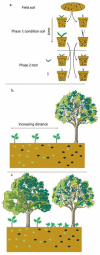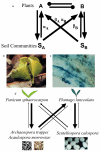Rooting theories of plant community ecology in microbial interactions
- PMID: 20557974
- PMCID: PMC2921684
- DOI: 10.1016/j.tree.2010.05.004
Rooting theories of plant community ecology in microbial interactions
Abstract
Predominant frameworks for understanding plant ecology have an aboveground bias that neglects soil micro-organisms. This is inconsistent with recent work illustrating the importance of soil microbes in terrestrial ecology. Microbial effects have been incorporated into plant community dynamics using ideas of niche modification and plant-soil community feedbacks. Here, we expand and integrate qualitative conceptual models of plant niche and feedback to explore implications of microbial interactions for understanding plant community ecology. At the same time we review the empirical evidence for these processes. We also consider common mycorrhizal networks, and propose that these are best interpreted within the feedback framework. Finally, we apply our integrated model of niche and feedback to understanding plant coexistence, monodominance and invasion ecology.
Copyright (c) 2010 Elsevier Ltd. All rights reserved.
Figures





References
-
- Chesson P. Mechanisms of maintenance of species diversity. Annual Review of Ecology and Systematics. 2000;31:343–366.
-
- Macarthur R, Levins R. The limiting similarity, convergence, and divergence of coexisting species. The American Naturalist. 1967;101:377–385.
-
- Tilman D. Resource competition and community structure. Princeton University Press; 1982. - PubMed
-
- Goldberg DE, Barton AM. Patterns and consequences of interspecific competition in natural communities: a review of field experiments with plants. American Naturalist. 1992;139:771–801.
-
- Dybzinski R, Tilman D. Resource use patterns predict long-term outcomes of plant competition for nutrients and light. American Naturalist. 2007;170:305–318. - PubMed
Publication types
MeSH terms
Grants and funding
LinkOut - more resources
Full Text Sources

